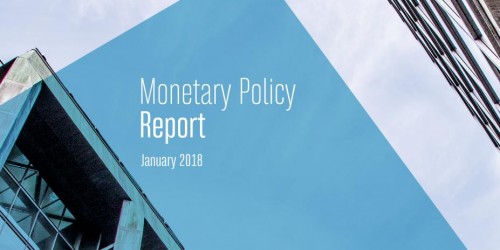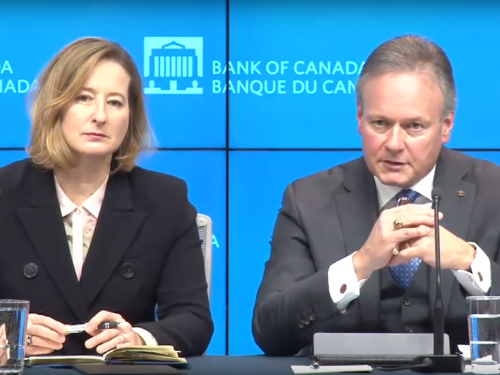Monetary Policy Report Press Conference Opening Statement
Good morning. Governor Poloz and I are pleased to be here to answer your questions about today’s interest rate announcement and our Monetary Policy Report (MPR).
The Canadian economy is operating close to its potential level of activity, and inflation is close to the 2 per cent target. In this context, Governing Council decided to raise the policy interest rate by one quarter of a percentage point to 1.25 per cent.
The data we have received since October have been generally stronger than expected. Growth around the world continues to strengthen and broaden, supporting the expansion here at home. We have upgraded the outlook for the US economy due to greater momentum and the new tax legislation passed late last year.
In Canada, economic growth is expected to average around 2 1/2 per cent in the short term, before slowing to a more sustainable pace over the projection horizon. This outlook remains clouded by uncertainty related to the future of the North American Free Trade Agreement (NAFTA).
In coming to our decision, there were three issues that Governing Council spent a lot of time discussing. Let me walk you through them.
The first issue was related to how much slack remains in the economy, and how that will evolve. Obviously, this is always an important question for an inflation-targeting central bank, but it is particularly so at this point in the economic cycle. Back in October, we said there were still signs of slack in the labour market. We also said that, even though we judged the economy was operating close to capacity, there was the possibility that more capacity would be created over time through business investment and an increase in labour market engagement.
The data we have seen suggest that labour market slack has indeed been narrowing, and somewhat more quickly than we had been expecting. The national unemployment rate has fallen to historic lows, average hours worked are recovering and our Business Outlook Survey points to signs of more intense labour shortages. That said, wage pressures remain modest. This could indicate that some capacity remains in the labour market. It could also indicate that wages have become less sensitive to pressure in the labour market, given the impact of global competition. Either way, wages do not appear to be a source of inflation pressure at this point. We published a staff analytical note today about wages, and will continue to monitor this issue.
In terms of new capacity creation, we have also seen positive signs. Business investment has continued to grow, our Business Outlook Survey shows that intentions remain positive, and historical data revisions imply that capacity is greater than we previously thought. New companies are typically a key source of capacity growth, and while it is still too early to determine the trend, recent data on firm creation have been encouraging.
We will update our views on the economy’s potential in the April MPR.
The second issue was how the evolution of capacity pressures will affect the outlook for inflation. As the Governor noted in a speech last November, a number of economists and policy-makers have been struggling to explain weaker-than-expected inflation in many jurisdictions. This has not been the case here in Canada, where core inflation measures have been increasing and behaving largely as we would have expected.
Inflation was actually a bit stronger than we projected in October, rising to just above our 2 per cent target near the end of last year. This was due to the temporary impact of higher energy prices. We expect a bit of a dip in inflation in the near term, largely because of the base-year effects of gasoline prices. The big picture is that we project inflation to fluctuate relatively close to target throughout the projection horizon.
That said, there is still the risk of a drag on inflation coming from global trends, such as digitalization in the economy. This will continue to be something that we watch closely.
The final key issue we discussed is how best to account for the uncertainty surrounding the renegotiation of NAFTA in our policy decisions.
Where trade policy decisions have already been taken, such as in the case of softwood lumber, we have built in their expected effects. In addition, while the results from the Business Outlook Survey were positive, an increasing number of firms told us that uncertainty surrounding the outcome of the talks is weighing on their investment decisions and, to a lesser extent, trade. Because of this, we added some more negative judgement to our profile for both business investment and exports.
Consistent with this approach, our outlook is based on the premise that current trade agreements will remain in place over the projection horizon. There are still a wide range of possible outcomes, which could play out over many different timelines. We do not know how the talks will conclude, and we do not know how governments will react to whatever outcome is reached. This means that trying to quantify any particular scenario would not be useful at this point for monetary policy purposes.
However, Bank staff have been working to determine the channels through which our economy could be affected by changes to trade policy. It is a subtle exercise. Economic theory tells us that there can be both upward and downward pressure on inflation. That is because changes to trade policy can work through multiple channels that affect both demand and supply in the economy over time. Such changes can also affect asset prices and the exchange rate. Whatever the outcome, we will be ready to assess the impact as it unfolds, and adjust monetary policy in a timely way, if required.
Taking all of these issues into account, Governing Council judges that while the economic outlook is expected to warrant higher interest rates over time, some continued monetary policy accommodation will likely be needed to keep the economy operating close to potential and inflation on target.
Continued stimulus is likely to be required for a time to take into account a number of factors. These include the effects of uncertainty related to trade negotiations, the expected effects of recent adjustments to mortgage lending policies, and the greater sensitivity of the economy to interest rates given high household indebtedness. In this context, raising the policy rate too quickly would risk stalling the expansion, and cause inflation to fall back below target. At the same time, raising the policy rate too slowly would risk a buildup of inflation pressures. Governing Council will therefore remain cautious in considering future policy adjustments, guided by incoming data in assessing the economy’s sensitivity to interest rates, the evolution of economic capacity, and the dynamics of both wage growth and inflation.
With that, Governor Poloz and I would now be happy to answer your questions.


